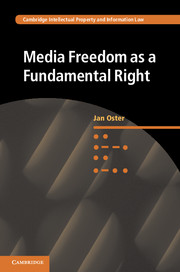Book contents
- Frontmatter
- Contents
- Preface and acknowledgements
- Table of cases
- Treaties, Conventions, Declarations and Statutes
- Reports and other documentary sources
- Introduction: aim, scope and method
- Part I The theoretical foundations of media freedom
- Part II General rules on media freedom
- Part III Specific limitations to media freedom
- 7 Personality rights and intellectual property as ‘rights of others’
- 8 Threats to public order interests: national security, territorial integrity, public safety and prevention of disorder and crime
- 9 The protection of health and morals
- 10 Maintaining the authority and impartiality of the judiciary
- 11 Incitement to hatred
- 12 Religiously offensive publications
- 13 Restrictions on commercial publications
- 14 Media pluralism
- Conclusion: tenets of a Media Freedom Principle
- Bibliography
- Index
- Cambridge Intellectual Property and Information Law
12 - Religiously offensive publications
from Part III - Specific limitations to media freedom
Published online by Cambridge University Press: 05 June 2015
- Frontmatter
- Contents
- Preface and acknowledgements
- Table of cases
- Treaties, Conventions, Declarations and Statutes
- Reports and other documentary sources
- Introduction: aim, scope and method
- Part I The theoretical foundations of media freedom
- Part II General rules on media freedom
- Part III Specific limitations to media freedom
- 7 Personality rights and intellectual property as ‘rights of others’
- 8 Threats to public order interests: national security, territorial integrity, public safety and prevention of disorder and crime
- 9 The protection of health and morals
- 10 Maintaining the authority and impartiality of the judiciary
- 11 Incitement to hatred
- 12 Religiously offensive publications
- 13 Restrictions on commercial publications
- 14 Media pluralism
- Conclusion: tenets of a Media Freedom Principle
- Bibliography
- Index
- Cambridge Intellectual Property and Information Law
Summary
For a long time, many sociologists believed that the ‘disenchantment’ of the (Western) world through enlightenment and rationalisation led to a privatisation of religious faith. The ‘authority of the holy’ had been replaced by the authority of consensus. However, the debates following the murder of Theo van Gogh in 2004, the Muhammad cartoon controversy in 2005 and the outrage caused by the ‘Innocence of Muslims’ video in 2012 are just a few well-known examples offierce conflicts between freedom of expression and religious feelings. The law of freedom of expression and media freedom has the important task of keeping public discourse on religious matters civil, despite the long underestimated significance and plurality of religious denominations in ‘post-secular societies’.
Countries’ attitudes towards the conflict between freedom of speech and religious freedom oscillate between ‘religious traditionalism’ and ‘secularist fundamentalism’. Religious traditionalism would suppress any speech that affects religious feelings. In April 1999, the UN Human Rights Commission approved a resolution entitled ‘Defamation of Religions’, which had originally been brought before the Commission by Pakistan under the draft title ‘Defamation of Islam’. On the initiative particularly of countries with a predominantly Muslim population, the Human Rights Commission and subsequently the UN Human Rights Council adopted several resolutions in opposition to ‘defamation of religion’. Similar resolutions were adopted between 2005 and 2010 by the UN General Assembly.
However, the concept of ‘defamation of religions’ is problematic. It is at odds with human rights doctrine, because human rights serve to protect individuals, not institutions or religions. Freedom of religion protects believers, not beliefs. Furthermore, it seems unjustifiable to distinguish ‘religion’ as particularly worthy of protection, as opposed to, say, ethnic origins.
- Type
- Chapter
- Information
- Media Freedom as a Fundamental Right , pp. 241 - 248Publisher: Cambridge University PressPrint publication year: 2015

